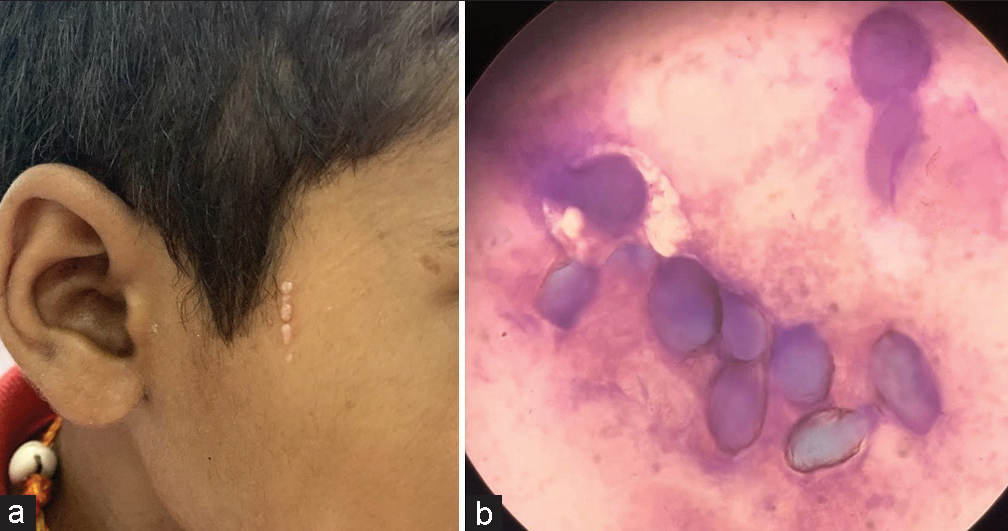Translate this page into:
Pseudo-koebnerization in a child

*Corresponding author: Arun Somasundaram, Department of Dermatology, Jawaharlal Institute of Postgraduate Medical Education and Research, Puducherry, India. arunsomasundaram25@gmail.com
-
Received: ,
Accepted: ,
How to cite this article: Somasundaram A, Murugan K. Pseudo-koebnerization in a child. CosmoDerma 2023;3:133.
A 6-year-old male child accompanied by his parents consulted the dermatology outpatient department for skin lesions over the face for 2 weeks. The child was not immunosuppressed and did not have any comorbid illness. Cutaneous examination revealed skin-colored shiny pearly white umbilicated papules over the forehead and zygomatic area. Skin lesions over the zygomatic area exhibited the pseudo-Koebner phenomenon (PKP) [Figure 1a]. Tzanck smear confirmed the diagnosis of molluscum contagiosum with molluscum bodies [Figure 1b]. Parents were reassured about the condition and the child was advised needling procedure for the same.

- (a) Skin-colored shiny pearly white umbilicated papules over the zygomatic area with pseudo-koebnerization evident, (b) Tzanck smear with molluscum bodies.
Koebner (isomorphic) phenomenon is the development of pathologic isomorphic skin lesions over traumatized uninvolved skin of affected patients with cutaneous conditions first described by Heinrich Koebner in 1877.[1] PKP is the induction of new lesions due to autoinoculation of infective material into the normal skin from a pre-existing focus most commonly noticed in viral warts or molluscum contagiosum.[1] This case was highlighted to observe and appreciate the phenomenon.
Declaration of patient consent
The authors certify that they have obtained all appropriate patient consent.
Conflicts of interest
There are no conflicts of interest.
Use of artificial intelligence (AI)-assisted technology for manuscript preparation
The authors confirm that there was no use of Artificial Intelligence (AI)-Assisted Technology for assisting in the writing or editing of the manuscript and no images were manipulated using AI.
Financial support and sponsorship
Nil.
References
- The isomorphic phenomenon of Koebner. Indian J Dermatol Venereol Leprol. 2004;70:187-9.
- [Google Scholar]





